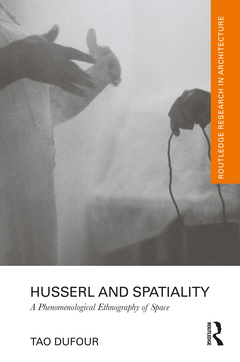Husserl and Spatiality A Phenomenological Ethnography of Space Routledge Research in Architecture Series
Auteur : DuFour Tao

Husserl and Spatiality is an exploration of the phenomenology of space and embodiment, based on the work of Edmund Husserl. Little known in architecture, Husserl?s phenomenology of embodied spatiality established the foundations for the works of later phenomenologists, including Maurice Merleau-Ponty?s well-known phenomenology of perception. Through a detailed study of his posthumously published and unpublished manuscripts on space, DuFour examines the depth and scope of Husserl?s phenomenology of space. The book investigates his analyses of corporeity and the ?lived body,? extending to questions of intersubjective, intergenerational, and geo-historical spatial experience, what DuFour terms the ?environmentality? of space.
Combining in-depth architectural philosophical investigations of spatiality with a rich and intimate ethnography, Husserl and Spatiality speaks to themes in social and cultural anthropology, from a theoretical perspective that addresses spatial practice and experience. Drawing on fieldwork in Brazil, DuFour develops his analyses of Husserl?s phenomenology through spatial accounts of ritual in the Afro-Brazilian religion of Candomblé. The result is a methodological innovation and unique mode of spatial description that DuFour terms a ?phenomenological ethnography of space.? The book?s profoundly interdisciplinary approach makes an incisive contribution relevant to academics and students of architecture and architectural theory, anthropology and material culture, and philosophy and environmental aesthetics.
Introduction: Spatial description; 1. Phenomenon and method: Fieldwork as methodological clue; Sensing history; 2. Corporeity and spatiality;Constitution and experience; Visual space; The spatial phantom and time;Tactual space, motility, and the lived body; Corporeity and time; 3. Space and the Other;The genesis of space; Empathic spatiality; Generative space; 4. A phenomenological ethnography of space;The reunião; Epilogue: Umweltlichkeit
Tao DuFour is an Assistant Professor at the Department of Architecture at Cornell University.
Date de parution : 05-2023
15.6x23.4 cm
Date de parution : 11-2021
15.6x23.4 cm
Thèmes de Husserl and Spatiality :
Mots-clés :
Spatial Experience; Husserl’s Theory; Edmund Husserl; Phenomenological Ethnography; Tao DuFour; Thing Lectures; architectural phenomenology; Kinaesthetic Motivation; ethnography of space; Husserl Archives; philosophy; Phenomenological Description; habitus; Lived Body; 20th century; Husserl’s Description; Ravine; Religious Praxis; Moon’s Light; Husserl’s Letter; Spatial Description; Husserl’s Philosophy; Open Intersubjectivity; Touch Sensation; Dan Zahavi; Husserl’s Treatment; Husserl’s Analyses; Husserl’s Writings; Husserl’s Concept; Husserl’s Lectures; Sense Perceptual Basis
